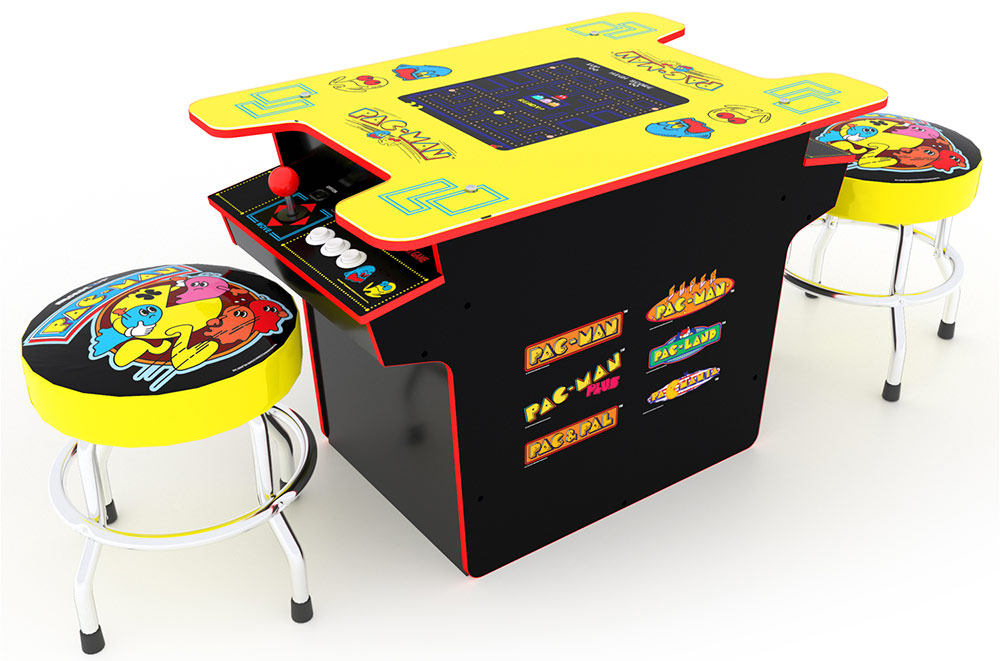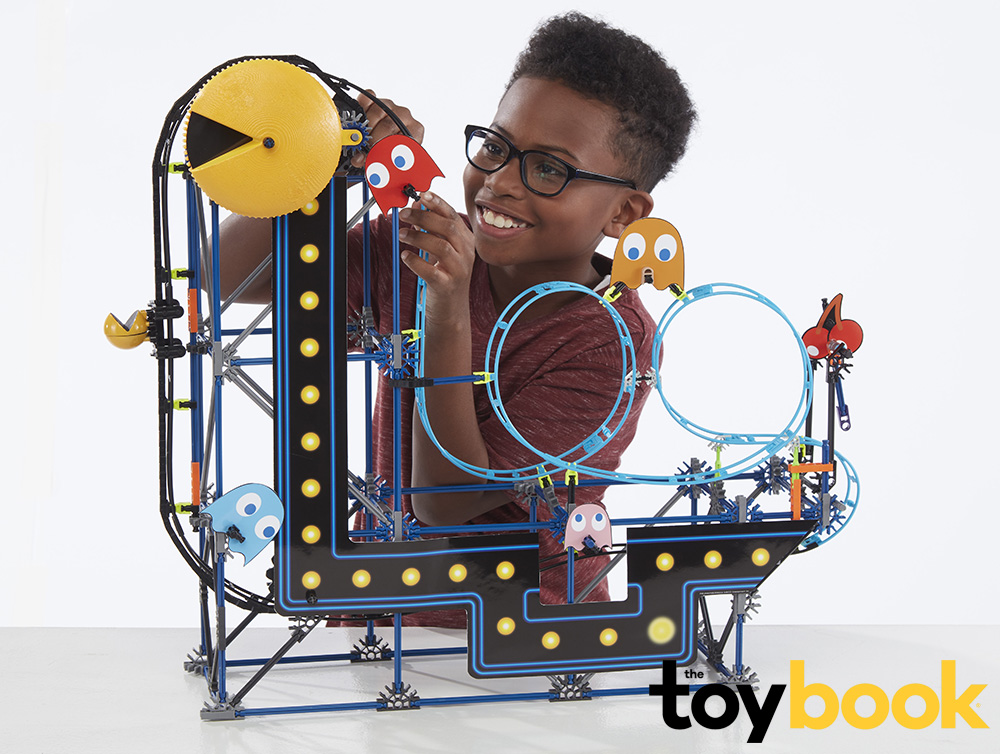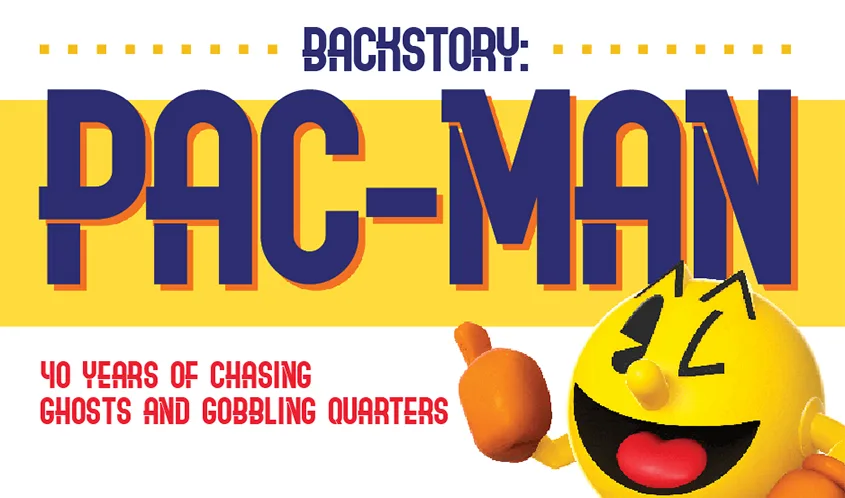Originally published June 30, 2020
On May 22, 1980, the world changed. Engineers from Namco plugged in and powered up the first public iteration of a new arcade game that put players in charge of a mysterious yellow creature with an insatiable appetite for power pellets, fruit, and ghosts.
Created by Toru Iwatani, Puck-Man was well-received by test audiences in Tokyo, and by mid-summer, the coin-op game was being played throughout Japan. Executives at Namco, eager to chase potential success in the growing U.S. arcade market, retitled the game Pac-Man — a nod to its working title, Pakkuman — a move Iwatani says was taken in hopes of evading arcade hooligans and vandals who may have had some fun with the original name in the U.S.
Namco took its cabinet to the Amusement Machine Operators of America’s annual trade show in November. There, the team showed Pac-Man alongside another maze-based Namco machine, Rally-X, that ran on the same internal hardware. Chicago-based Midway Games snapped up rights to both titles, and by December, Pac-Man was on its way to gobbling up quarters in arcades and bars across the country. Its appeal was widespread and resonated with all ages.

“Pac-Man is addictive. Simple to play without complex rules or even specific skills needed, most players — young and old, gamers and non-gamers — can jump right in and understand the objectives,” says Alan Dorfman, president of Super Impulse, the company behind the Tiny Arcade, Micro Arcade, and World’s Smallest toy lines. “The little yellow main character subconsciously reminds us of a smiley face, so we want him to succeed.”
And he was succeeding. By 1982, Pac-Man was a certified global phenomenon, and in the U.S. alone, it was estimated that nearly 30 million players had spent more than $1 billion in quarters on the game.
Like Dorfman, Pearl Lai, a brand manager at Bandai Namco America Inc., credits the simplicity of the game with its immediate — and lasting — appeal.
“Great gameplay design always keeps players coming back for more,” Lai says. “Pac-Man’s core gameplay design is simple and easy to grasp: Eat all the pellets to clear a stage while running away from those pesky ghosts, or turn the tables and go on the attack after eating a power pellet.”
Dorfman says that turning the tables on the ghosts — Inky, Blinky, Pinky, and Clyde — is “indescribably satisfying.”
The universal appeal of Pac-Man set off a licensing frenzy that launched the game into the realm of a transmedia crossover franchise, including toys, music, an animated series, and a multitude of home games.
PAC-MAN FEVER
Jerry Buckner and Gary Garcia were primarily known for cranking out corporate jingles until a dinner outing in Marietta, Georgia, changed their course. After seeing kids plopping quarters into a head-to-head Pac-Man game, the duo got hooked on the game, which inspired a song that coined a national catchphrase: “Pac-Man Fever.”
Buckner & Garcia pressed singles on vinyl, which quickly sold out in the local market. The brisk sales and local radio play drew the attention of CBS Records, which inked a deal with the duo for a full album of arcade-inspired tracks. “The real turning point occurred when Entertainment Tonight featured a story on us, and literally overnight, the record exploded,” Buckner says.
“Pac-Man Fever” peaked at No. 9 on the Billboard Hot 100 in March 1982 and sold more than 1.2 million copies by the end of the year.
The craze was a genuine phenomenon, and the game went on to become the bestselling arcade cabinet in U.S. history, with more than 400,000 units installed across the country. According to news reports at the time, Midway’s manufacturing facility in Franklin Park, Illinois, was churning out 350 Pac-Man units every day across three different cabinet styles.
More than 100 licensees — including Milton Bradley, Fleer, TOMY, Coleco, Tiger Electronics, Ben Cooper, Duncan, Ideal, and Wham-O — were churning out products in every conceivable category. The billion-dollar sales of Pac merch ran the gamut from traditional toys — such as yo-yos, plush, and flying discs — to oddball pieces, including bar soap, air fresheners, and even cigarette lighters.
In less than two years on the market, sales of Pac-Man-branded merchandise had also crossed the billion-dollar mark, notably pulling ahead of Lucasfilm’s Star Wars: A New Hope, as reported in the spring 1988 issue of Screen magazine.
By year’s end, Midway, now a division of Bally’s, had also churned out several Pac sequels, including Ms. Pac-Man, Pac-Man Plus, Super Pac-Man, and Baby Pac-Man, in an effort to chase the craze from every angle. Unfortunately, the sequels were never fully authorized by Namco and led to an end of the companies’ partnership agreement. Decades later, following Midway’s bankruptcy and liquidation, the rights to those games eventually reverted to Bandai Namco, current owner of all things Pac.
THE PAC-MAN LEGACY
This year, a rejuvenated Pac-Man licensing program is bringing the fever back to retail with new toys, games, and consumer products from Basic Fun!, Arcade1Up, Buffalo Games, and more. Fashion and lifestyle collaborations from Champion, Timex, Kipling, and Bait will give older fans new ways to express their Pac fandom.
Super Impulse recently released a Tiny Arcade version of the tabletop Pac-Man cabinet that inspired “Pac-Man Fever” and will release Pac-Man Tilt later this year.
“Since Pac-Man is so iconic, it is important that we don’t mess with a winning formula,” Dorfman says. “[We] keep the products traditional, accurate, and true to gameplay.”
Bandai Namco is calling upon fans to “Join the Pac” through a yearlong promotional campaign.
“We’ve got a ton of activities planned to celebrate Pac-Man’s 40th birthday,” says Bandai Namco’s Lai. Prior to the spread of the COVID-19 pandemic, the company inked a Pac-Man sponsorship deal with the San Francisco Giants for the team’s Giant Race Series. Additionally, Bandai Namco had intended to launch some big activations at the since-canceled Comic-Con International: San Diego (SDCC) that are now on hold.

Drawing from the past for inspiration, the “Join the Pac” campaign is anchored by a new theme song from Japanese Techno artist Ken Ishii, delivered complete with a music video from director Yuichi Kodama.
On the August 29 Record Store Day Drop, iam8bit Japan, in collaboration with United Music and Arts, will release a limited-edition, 7-inch Pac-Man single to independent record stores in the U.S. and the UK. The single will feature “Join the Pac (Official Theme Song for Pac-Man 40th Anniversary: Club Mix)” on the a-side, with “The World of Pac-Man (Theme Song for Pac-Man Challenge: Original Mix)” on the b-side.
“The iam8bit Japan team has wanted to collaborate with Bandai Namco on a Pac-Man project for a long time — it was just about finding the perfect fit,” says iam8bit Co-Founder Jon M. Gibson. “When a conversation swirled around the big, yellow guy’s 40th anniversary, everyone got very excited about what a modern musical take on vinyl could look like, and it was an absolute dream to work with the legendary Ken Ishii to make it happen for Record Store Day 2020.”
In many ways, Pac-Man feels fresher than ever, as the industry is in a retro entertainment wave that shows no signs of slowing down.
“Pac-Man is a universal icon who never wears out his welcome,” Buckner says. “I liken it to The Beatles of video games. It is simplistic, dated, and limited by today’s standards, but it’s fun to play and still offers a challenge to players. Pac-Man is an original and will remain relevant for a long time to come. Its history is deep-rooted, and there’s just nothing quite like it out there.”
This article was originally published in the June 2020 issue of the Toy Book. Click here to read the full issue!

